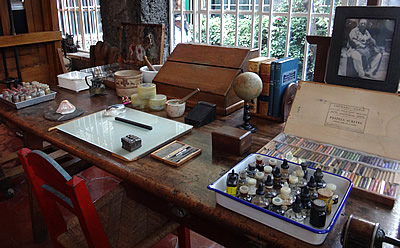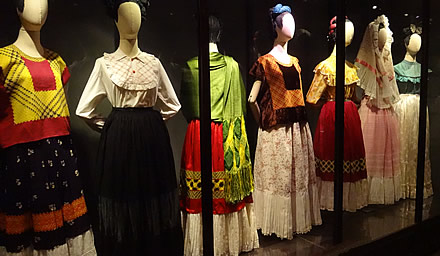

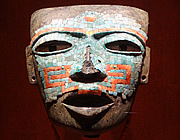
The Anthropology Museum in Mexico City is one of the world's greatest and really needs much more time than we were able to devote to its magnificent collections.
Frida Kahlo's colourful home is where she lived with Diego Rivera, whose wonderful murals around the city illustrate the lives of ordinary Mexicans through the ages.
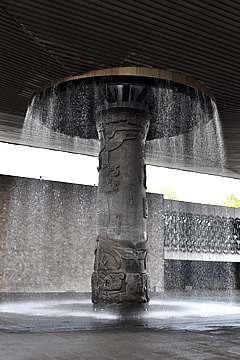
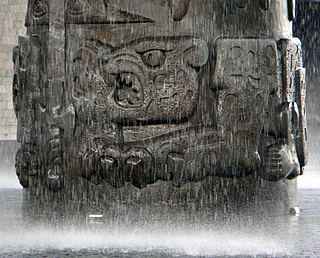
Early on a Sunday morning our guide Pepe picked us up on the corner of the block. A lot of the roads are closed on Sunday mornings until 2pm so that bicycles have free run, so he couldn't get the car right to the hotel.
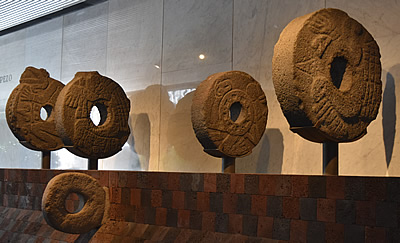
We drove through the quiet streets to the world-famous Anthropological Museum.1 The galleries are set around an internal courtyard with an impressive waterfall fountain carved with eagle and snake, jaguars and helmeted warriors, and topped by a sun disk.
The museum is large and stuffed to the gills with interesting artefacts. Pepe wanted to concentrate on the history and myths of the Aztec (Mexica) people, but we had time to quickly view the other galleries - the museum really deserves at least a full day.
The Olmecs are thought to be the first "civilisation" in the region, flourishing between 1800 and 400 BC, during what are termed the Early and Middle Preclassic periods.
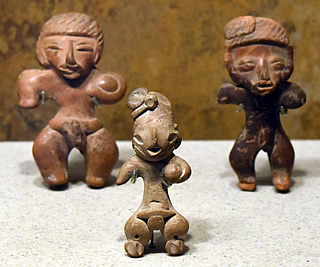
 "The Wrestler"
"The Wrestler"Their origins are most probably in southern Veracruz and Tabasco1 and the greatest Olmec sites are found here. The Olmecs were master stone carvers and their sculpted figures are lifelike and three-dimensional - chubby baby-like figurines feature a great deal. Many carvings have cleft heads, fleshy lips or feature jaguars. The jaguar was sacred to the Olmecs, specially in the form of a were-jaguar - half man half beast.
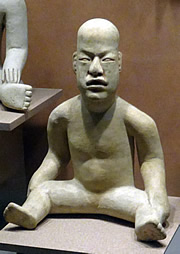 Typical Olmec "baby" figurine.
Typical Olmec "baby" figurine.The most famous, and curious, of their works are massive carved stone heads which are thought to represent Olmec rulers. The heads have very individual features and were almost certainly carved to represent real people.
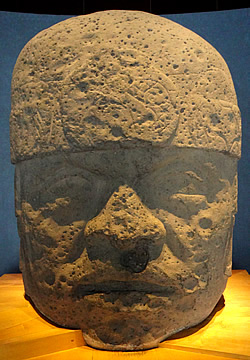
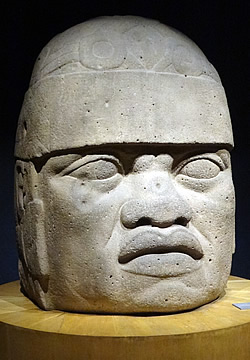
At San Lorenzo in the heart of the Olmec region ten such heads were discovered. Each weighing many tons, the biggest almost three metres high, they are truly colossal. The basalt from which they were made has been identified as coming from 50km away and it is postulated that the huge raw boulders must have been transported by river as far as possible, on wooden rafts, and then dragged, perhaps on wooden rollers, to the site.
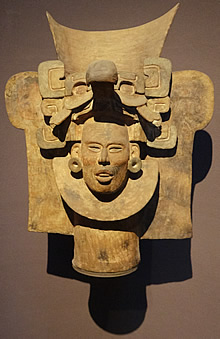
The Zapotec people rose to prominence as the Olmecs declined. Around 500-450 BC they built their magnificent city of Monte Alban, west of Oaxaca. We were due to visit Monte Alban later so were keen to see what we could see and learn in the museum.
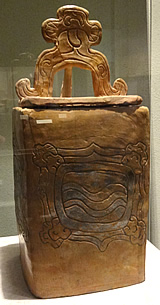
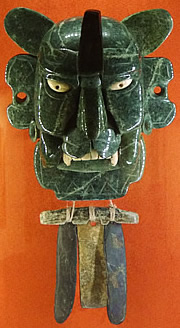
They were one of only two Mexican civilisations up to this point that had developed both writing and a calendar. Only the Maya had a more fully developed hieroglyphic script which recorded the spoken language.2
The Zapotec had at least some interaction with the lowland Maya (who inhabited roughly the current-day Yucatan peninsula) as there are clear Mayan influences in artefacts.
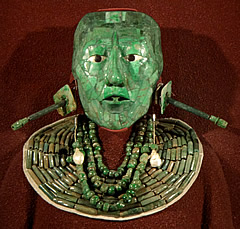
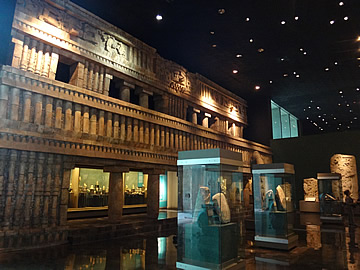
The museum has an impressive collection of Mayan artefacts - the civilisation as a whole was perhaps the longest lived in the Mexican region, beginning in the Preclassic around 200BC, reaching its peak between 250 and 900 AD, after which it declined substantially, though still having a presence at the time of the conquest. Great cities such as Calakmul, Tikal, Palenque, Copan and Yaxchilan rose and fell.
Monte Alban is one of the few great mesoamerican sites to perpetuate right up until the conquest, though under different peoples. The height of Zapotec Monte Alban was in the late Preclassic leading up to the Classic period, where civilisation in the region reached its peak. The Classic period in Mexico lasted roughly from150 to 650 AD.
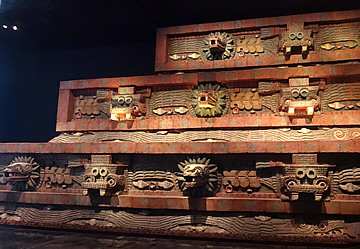
The greatest city of all was Teotihuacan. It was so revered by the Mexica (Aztecs) that they believed the gods were actually here. Its monumental pyramids and temples ranged either side of a broad avenue over 3 km in length impressed them immensely. The city surrounding the so-called Avenue of the Dead was vast, covering 20 sq. km.2 and laid out on a grid.
The Teotihuacanos were literate, but used their hieroglyphic system mainly to accompany images giving dates, names or locations.2
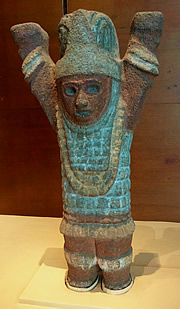
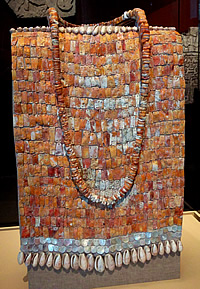
Alongside the important gods of fire, rain and maize, the Feathered Serpent was revered and depictions of it, and use of the distinctive talud-tablero architectural style, spread far and wide, a testament to the influence of the city. This influence had subsided by 600 AD and the palaces seem to have been deliberately destroyed, no-one knows why, but since the city around the monumental centre continued to function for another two centuries, perhaps the elite were specifically targetted.
Tula was one of the centres which grew to be influential following the decline of Teotihuacan. It flourished around 900 AD and was a Toltec stronghold from which they established a great empire, stretching from northern Mexico down to the Guatemalan highlands and encompassing much of the Yucatan peninsula.2 The Toltecs were known as highly skilled craftsmen and some of the artefacts that have come down to us certainly display a high degree of artistry.
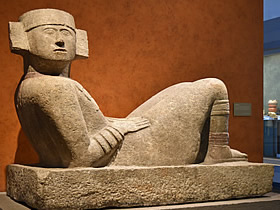
Chichen Itza, probably the most famous, but not at all the greatest, mesoamerican centre, had its roots in Mayan civilisation but bears many similarities to Tula, nor least the ubiquitous Feathered Serpent, which is not a Mayan concept.
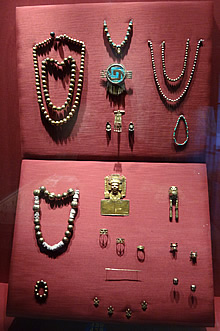
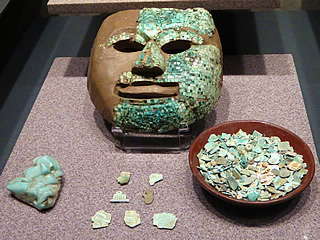
In these Post Classic times the Mixtecs of the Oaxaca region flourished as the Toltecs further north were declining. They inherited much from the Zapotecs, not least Monte Alban, and were also highly skilled artisans, especially in the working of rock crystal, jade, gold and turquoise.2
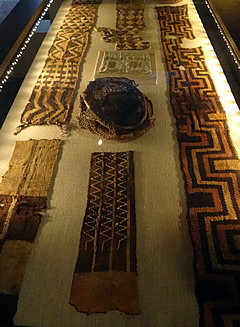
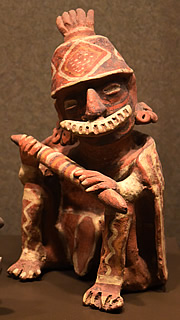
The museum has far too many exhibits - far too many highlights! - to do it justice here. I haven't even mentioned cultures covered in the Occidente and Norte galleries - and I was particularly impressed by the amazingly well-preserved textiles in the latter.
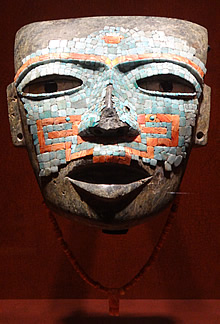
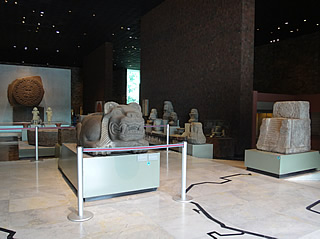
The largest part of the Museum's collections is devoted to the Aztec culture, and Pepe was very keen that we get a thorough understanding of their development and beliefs so we'd have a good grounding for our subsequent visits to the archaeological sites.
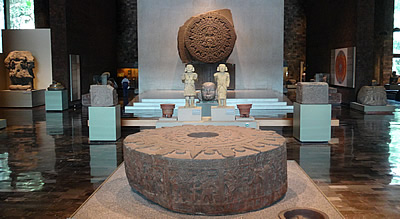
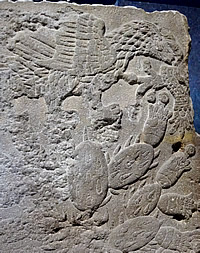
A lot of what we learned I've used on the Tenochtitlan page so I won't go into detail here. Suffice to say that the Aztecs came from Aztlan, in the north of Mexico, looking to settle in a new land, which they would know, according to their guiding deity Huitzilopochtli by the appearance of an eagle perched on a cactus with a snake in its beak. This duly happened at the Great Lake in the Valley of Mexico where they built there city of Tenochtitlan and where now the modern day Mexico City grew up after the conquest. Part myth, part history but a colourful tale nonetheless.
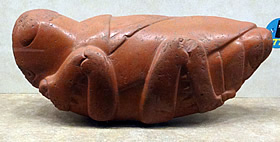
The Aztecs, along with other mesoamerican cultures, recorded much on codices, inscribed on lengths of deerskin or bark paper and folded concertina-fashion. This included economic information, maps, pictorial representations of mythic beliefs and possibly historical works.
Unfortunately the Spanish Franciscan friars embarked on a campaign of burning as many of these as they could lay their hands on, believing them to be heretical and an obstruction to conversion of the local people to Christianity. Colonial-era codices do survive, in the same pictorial style but with European influence.
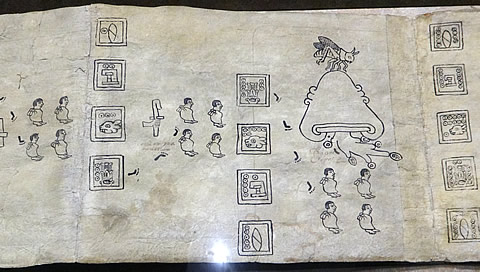
One of the most important codices is the Boturini Codex which pictorially chronicles the migration of the Aztecs from their original homeland of Aztlan to Chapultepec (Grasshopper) Hill and Tenochtitlan. It was created perhaps ten years after the conquest.
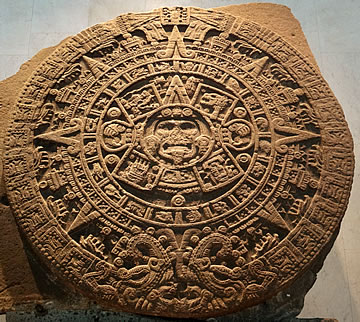
The most famous of the exhibits is the Sun Stone, almost four metres in diameter it was though to have been destined to be a sacrificial stone but became flawed through a large crack on the back. It was once part of the Great Temple of Tenochtitlan and is covered with iconography representing part myth of the creation of the world and calendar symbols.
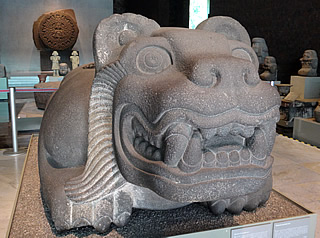
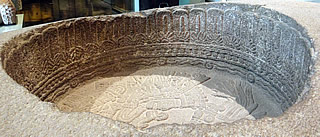
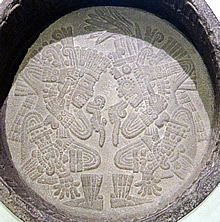
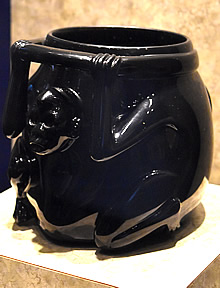
The Aztecs believed that they lived in the fifth incarnation of creation, the previous four having failed because of the failures of man. This age had been created through two gods sacrificing themselves in fire. Thus in the Sun Stone The face of Xiuhtecuhtli, the fire god, emerges from the centre of the disc, his tongue in the shape of a tecpatl, a ceremonial knife, and he holds bleeding hearts in each of two claws.
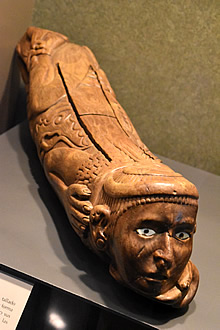
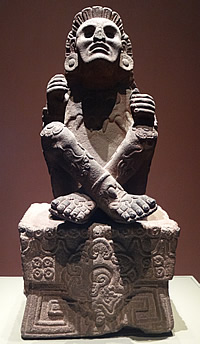
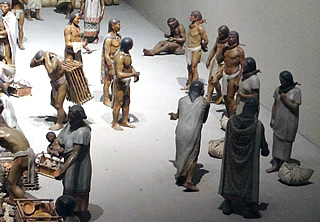
There is a very nice model of an Aztec market place which allowed Pepe to explain various aspects of Aztec life. A type of hairless black dog was considered sacred and highly prized, not least because their bodies gave off heat which could warm a room! When the owner died the dog was killed and buried with him and acted as a guide in the afterlife.
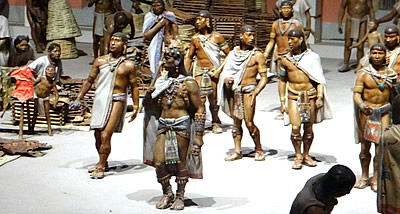
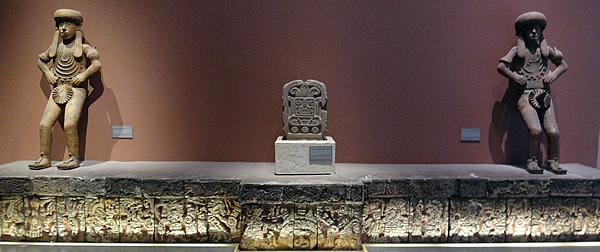
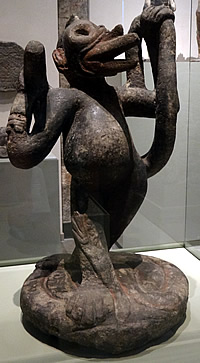
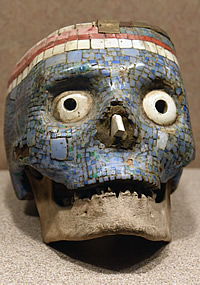
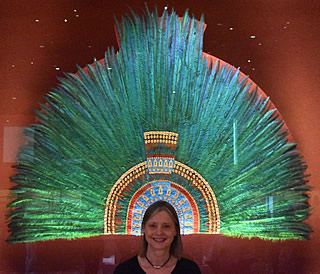
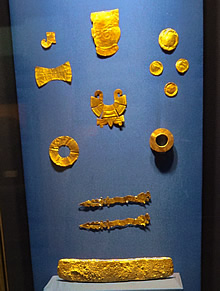


There is little left of the fabulous Aztec gold which caused their downfall, driving the Spanish to terrible acts of destruction and cruelty. It has to be said that they were aided by other mesoamerican cultures who had suffered terribly under the Aztecs!
I made a fleeting visit upstairs in the museum to see the ethnic collections - lots of costumes and displays showing village life and activities, but I really had no time to study anything!
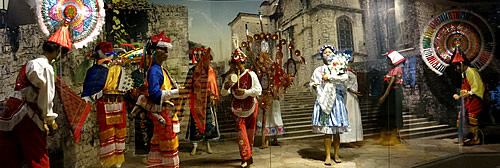
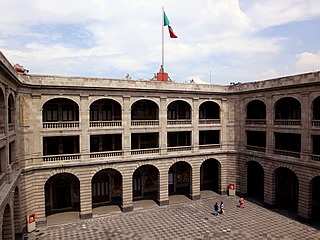
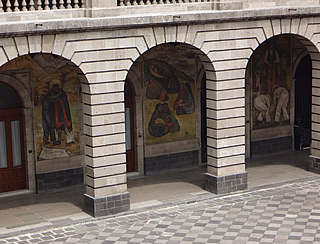
Having seen the wonderful Diego Rivera murals in the Palacio Nacional, we made a special excursion to the Secretaria de Educacion Publica where there are an immense number of his works covering the walls of two courtyards. Rivera intended the panels to cover all the life of the Mexican worker and subjects range from agricultural to factory work, fiestas and celebrations, demonstrations and political meetings - not surprising as Rivera was a fervent Communist.


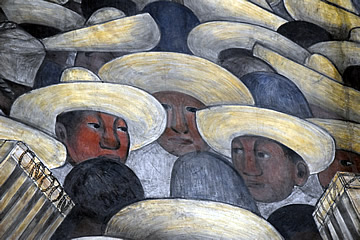
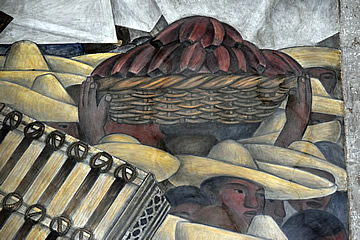
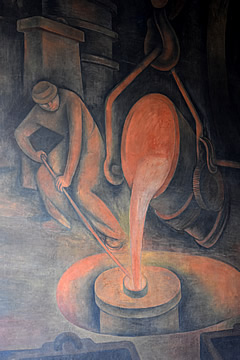
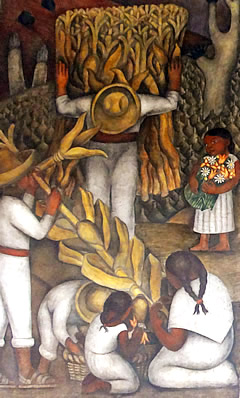
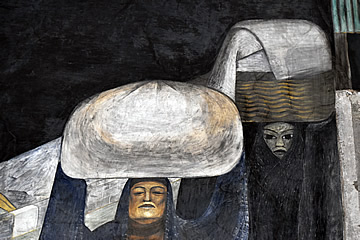
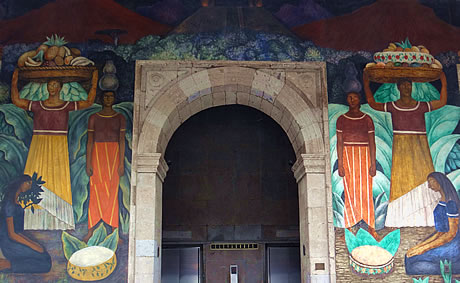
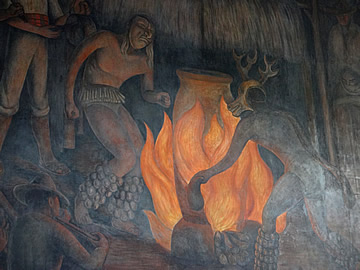
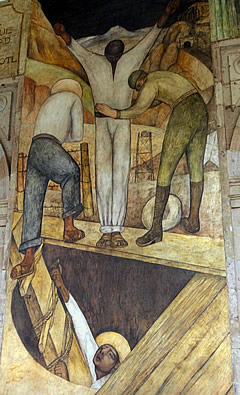
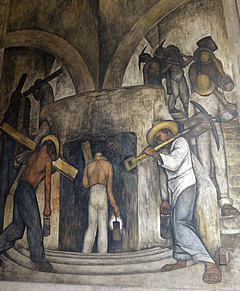
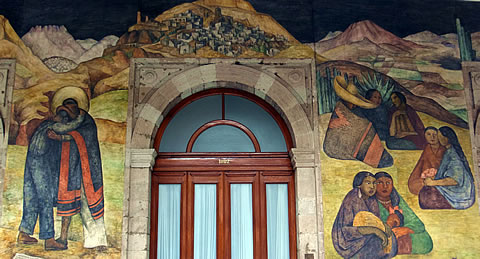
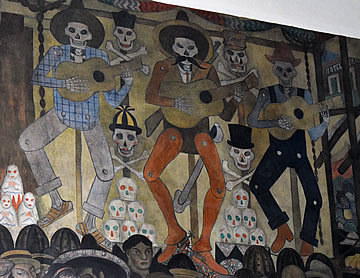
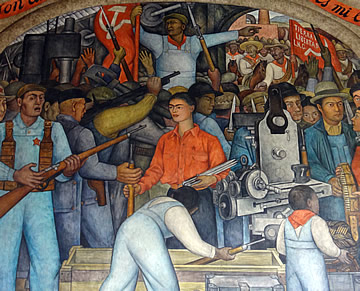
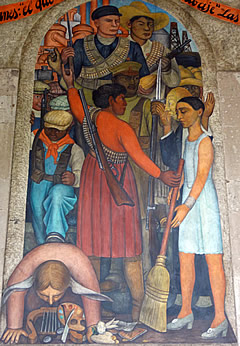
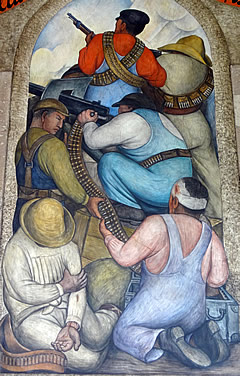
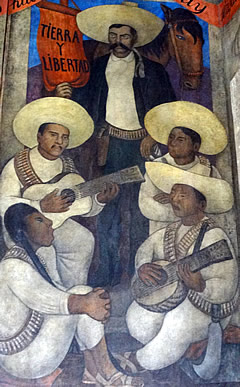
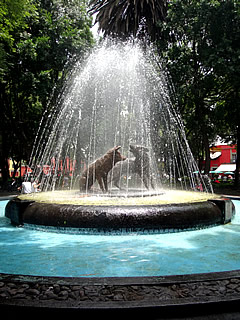


We took the metro one morning south to General Anaya then walked west to the pleasant historic centre of Coyoacan. Originally an Aztec village, now much modernised of course, and part of the urban sprawl of Mexico City.
The centre is very pleasant with a shady central square. We walked a few blocks north to the Frida Kahlo museum and were astonished to see a huge queue. Forty minutes later we were inside La Casa Azul - the blue-painted house where Frida Kahlo was born in 1907. It's necessary to buy a photo permit, which we did, in order to take photographs inside.
As a child she suffered from polio which left her with a withered right leg. Even more tragically she was involved in a bus crash at the age of 18 when a metal pole pierced her body. She was extremely lucky to survive. Kahlo began painting while she was recovering from the accident.
She married the celebrated muralist Diego Rivera in 1929 but ten years later divorced him because of his many infidelities culminating in an affair with Kahlo's sister. However, they remarried a year later. They lived together in the house for many years. and she died there in 1954.
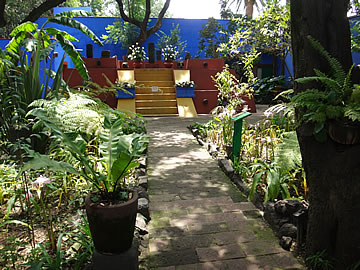
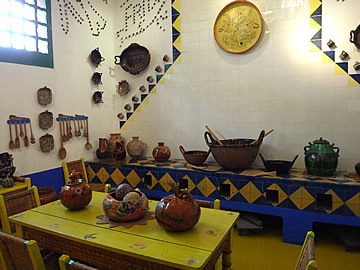

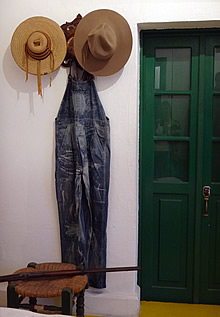
Rivera was a communist and, when Trotsky was offered asylum in Mexico in 1937, he and his wife first stayed at Casa Azul.

There are many of Kahlo's works on display, including several self-portraits in various guises and portraits painted by other artists. She is unmistakable with her thick monobrow.
I can't say I'm a big fan of her work, but I loved the bright colourful house and garden. It is well worth a visit, but best to buy tickets online before arriving!
